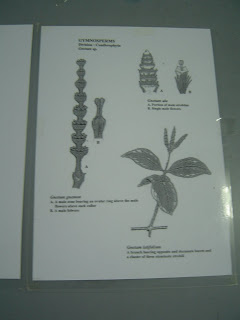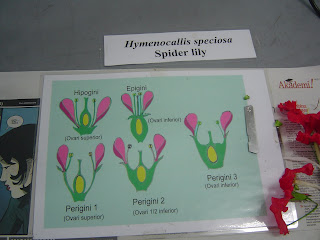Flowering plants (angiosperms) comprise about 90 percent of the Kingdom Plantae. The total number of described species exceeds 250,000, and many tropical species are as yet unnamed. During the past 130 million years, flowering plants have colonized practically every conceivable habitat on earth, from sun-baked deserts and windswept alpine summits to fertile grasslands, freshwater marshes, dense forests and lush mountain meadows. Although a number of flowering plants live in aquatic habitats and have adapted to the saline conditions of dry lake beds and salt marshes, relatively few species live submersed in the oceans.
True marine angiosperms are found throughout the oceans of the world, although most species are distributed in tropical regions. They are sometimes referred to as "seagrasses" and include about 50 species in 12 genera. Virtually all flowering plants produce some type of functional floral organ, although in some families such as the Lemnaceae, the flowers are microscopic and are seldom seen by the casual observer. Certain grasses and specialized cultivars apparently do not produce flowers, although they may still have rudimentary flowers (vestigial floral parts).
The three largest flowering plant families containing the greatest number of species are the sunflower family (Asteraceae) with about 24,000 species, the orchid family (Orchidaceae) with about 20,000 species, and the legume or pea family (Fabaceae) with 18,000 species. [Judd, W.S. et al. 2008 Plant Systematics: A Phylogenetic Approach lists 23,000 for Asteraceae, 19,500 for Orchidaceae and 18,000 for Fabaceae.]
The total number of species for these three enormous families alone is approximately 62,000, roughly 25 percent of all the flowering plant species on earth. To put it another way, if you randomly lined up all the species of flowering plants on earth, every fourth one would be an orchid (Orchidaceae), a sunflower (Asteraceae) or a legume (Fabaceae). The state of California (where Wayne's Word is based) includes about 5,000 native and naturalized species, and 41 percent of these species belong to the following six plant families: sunflower family (Asteraceae), grass family (Poaceae), legume family (Fabaceae), snapdragon family (Scrophulariaceae), mustard family (Brassicaceae), and sedge family (Cyperaceae).
The two largest plant families are the sunflower family (Asteraceae) with 24,000 species and the orchid family (Orchidaceae) with about 20,000 species.
Some of the largest herbaceous (nonwoody) genera of flowering plants include sedges (Carex: 900), lupines (Lupinus: 300), asters (Aster: 600), onions (Allium: 500), rein orchids (Habenaria: 600), tree orchids (Dendrobium: 900), bulb-leaf orchids (Bulbophyllum: 1000), dancing-lady orchids (Oncidium: 500), indigo (Indigofera: 700), sorrel (Oxalis: 800), geranium (Geranium: 375), nightshade (Solanum: 1400), penstemon (Penstemon: 300), and the amazing locoweeds (Astragalus) with an estimated 2,000 species worldwide.
Some of the largest woody plant genera include Acacia (800), Eucalyptus (500), holly (Ilex: 440), Eugenia (600), heather (Erica: 860), passion fruit (Passiflora: 400), sage (Salvia: 800), rattan palm (Calamus: 340), Cassia (500), Croton (1300), Prunus (200), Philodendron (250), Euphorbia (2400), and figs (Ficus: 800-1000). Not only are there at least 800 species of figs in the world, but they all have their own "in house" species of pollinator wasp.
The enormous genus Acacia has evolved into two main groups. One group includes species bearing phyllodes (broadened leaf petioles functioning like leaf blades). Another group includes species with fernlike, pinnate leaves divided into small leaflets
Some flowering plants do not have photosynthetic chlorophyll-bearing (green) leaves and are completely parasitic on the stems and roots of other plants. In order to grow and reproduce, they must absorb their vital carbohydrates (sugars) and amino acids from the host plant. Some of these root and stem parasites include the most bizarre plants on earth. Since they are nonphotosynthetic, they are also called heterotrophic like most animals and humans. Some heterotrophic plants look more like pale, fleshy fungi than flowering plants. They live in the deep humus of shady forests and include some very strange and colorful species. These "fungus flowers" are referred to as "mycotrophic" (fungus-nutrition) because their carbohydrates and amino acids come from mycorrhizal soil fungi which are in turn attached to the roots of nearby forest trees. Like true parasitic flowering plants, mycotrophic wildflowers must absorb their energy-rich molecules from other host plants, but unlike the direct root and stem parasites, their carbohydrates and amino acids are derived from nearby root systems via a conduit of filamentous soil fungi. Using labeled sugars containing radioactive carbon 14, scientists have shown that carbohydrates synthesized by nearby trees pass into the mycorrhizal soil fungi and eventually into the mycotrophic "fungus flowers."
But of all the marvelously adapted flowering plants, the carnivorous plants are truly the most amazing. Nitrogen is an essential element for all plants and animals because it is a key component of protein. It is abundant in the atmosphere and in the decaying organic matter of ponds and bogs where carnivorous plants commonly grow. However, the primary usable forms of nitrogen for plants are nitrates, produced from the decay of organic matter by the action of certain bacteria. Bogs containing carnivorous plants are often too acidic for the nitrate-forming bacteria. Herein lies the adaptive advantage of capturing insects as a supplemental source of usable nitrogen. The ingenious methods by which flowering plants are able to capture and digest small animals, such as insects and crustaceans, is absolutely remarkable.
Flowering plants represent an extraordinary diverse group of life forms. Although they all produce flowers and seed-bearing fruits, they come in an astonishing variety of shapes and sizes. Flowering plants range in size from minute wolffia plants (Wolffia globosa) less than a millimeter (1/25th of an inch) long to giant Australian eucalyptus trees (Eucalyptus regnans) over 300 feet (100 m) tall. Although the current record-holder for tallest tree is actually a 379 foot (116 m) conifer called the California redwood (Sequoia sempervirens), a fallen Eucalyptus regnans measuring 18 feet (5.4 m) in diameter and 435 feet (133 m) tall was reported from Australia in 1872. According to Stan Kelly (Eucalypts Volume 1, 1977), the tallest E. regnans currently standing is 322 feet (98 m).
The common connecting link between all flowering plants is that they produce sexual reproductive organs called flowers. A flower is composed of 4 major parts: petals, sepals, stamens and one or more pistils (see above diagram). The number, shape, size, and arrangement of these floral parts varies considerably with different plant families, and is reflected in the tremendous diversity of flowering plants. According to the foremost authority on angiosperm diversity and phylogeny Dr. R.F. Thorne (The Botanical Review Volume 58: 225-348, 1992), the total number of different flowering plant families is 437. This great number of families is subdivided into 400 subfamilies, 12,650 genera and 233,885 species. For example: The grass family (Poaceae) has 3 stamens and one pistil, but no petals or sepals. The duckweed family (Lemnaceae) has one stamen and one pistil, and no petals or sepals. The cactus family (Cactaceae) has numerous stamens, one pistil, and numerous petals and sepals. The buttercup family (Ranunculaceae) has many stamens, many pistils, many petals and many sepals. Families with many separate floral parts (such as the Magnoliaceae and Ranunculaceae) are considered more primitive. Families with fewer floral parts which are fused together and irregularly shaped (such as the Orchidaceae) are considered more advanced in the evolution of flowering plants. Flowers without colorful petals and sepals are typically wind-pollinated and do not need showy parts to attract insects. Colorful, insect-pollinated flowers also produce sweet (sugary), fragrant nectar in nectar glands at the base of the blossom, which further entices insects to visit them.
One of the largest genera of flowering plants is Euphorbia with approximately 2,000 species. This enormous genus belongs to the very diverse euphorbia family (Euphorbiaceae). The variation within this genus is astonishing, from low-growing garden weeds called spurges to giant, cactus-like succulents that rival in size our North American sahuaro and organ-pipe cacti. South African euphorbias have evolved succulent, spine-covered stems that greatly resemble North American cacti, a biological phenomenon known as convergent evolution. It is difficult to believe that all these diverse forms belong to the same genus as the showy garden euphorbia called poinsettia (E. pulcherrima) until you carefully examine the blossom. The showy, red, modified leaves of poincettia are not petals. In fact, they are not even part of the true flowers. They surround clusters of small, greenish, cup-shaped structures called cyathia. Each cyathium is actually a flower cluster or inflorescence containing unisexual, apetalous male and female flowers. The inconspicuous male flowers occur in clusters and are reduced to a single red stamen, while the female flower consists of a single ovary (pistil) on a stalk (pedicel). In poinsettia the ovary is hidden within the cyathium, but in other species the ovary protrudes out of the cyathium at maturity. The rim of the cyathium also bears one-several, greenish nectar glands that are attractive to insect pollinators. In some species the glands are subtended by petal-like bracts (petaloid appendages). Poinsettias typically have only one greenish gland per cyathium and no petaloid appendages. This flower plan is quite different from the typical floral diagram above, but it is the basic theme in virtually all members of the amazing genus Euphorbia. It should be noted here that some authorities place the prostrate, herbaceous euphorbias (called spurges) with C-4 photosynthesis in the genus Chamaesyce.
Many members of the euphorbia family, including the genus Euphorbia, contain a poisonous milky-latex sap. The toxin is a mixture of diterpene esters, and contact with the skin may cause inflammation and a blistering rash. An Australian company called Peplin Biotech is conducting research on the sap of E. peplus as a simple topical treatment for certain skin cancers, such as basal cell carcinomas and squamous cell carcinomas. These are the most common human cancers, particularly in people who spend a lot of time outdoors in direct sunlight. For years, people in Australia have used the milky sap of E. peplus to cure cancerous spots on their skin. The fresh sap from E. peplus is applied directly to the cancerous spot. After a few days the area develops into an enlarged, swollen sore, followed by a scab that eventually dries and falls off. According to Peplin Biotech, the sap penetrates the skin and destroys the malignant tissue. This is essentially what happens when a dermatologist applies liquid nitrogen directly to a superficial cancerous growth on the skin. Whether this remarkable discovery is ever patented remains to be seen.
The duckweed family (Lemnaceae) includes the undisputed smallest and fastest reproducing flowering plants in the world. In fact, the genus Wolffia is Mr. Wolffia's (the editor of Wayne's Word) favorite plant group. Imagine flowering wolffia plants (genus Wolffia) that weigh only 150 micrograms (1/190,000 of an ounce), or the approximate weight of two ordinary grains of table salt. Individual wolffia plants are 165,000 times shorter than the tallest Australian eucalyptus tree and 7 trillion times lighter than the most massive giant sequoia tree. They are carried from pond to pond on the feet of water fowl (tucked neatly under the ducks' bodies during flight), and there are records of wolffia plant bodies being carried by a tornado. They have even been reported in the water of melted hailstones. One wolffia plant is small enough to slip through the eye of an ordinary sewing needle, and at least 5,000 plants could be packed into a thimble. Each plant produces a microscopic flower inside a small cavity that develops on the upper side of the plant body. The minute flower consists of a single pistil and stamen. A bouquet of one dozen plants in full bloom will easily fit on the head of a pin. After pollination the ovary develops into a tiny one-seeded fruit called a utricle, which also holds the record for the world's smallest fruit.
http://waynesword.palomar.edu/trmar98.htm








































































